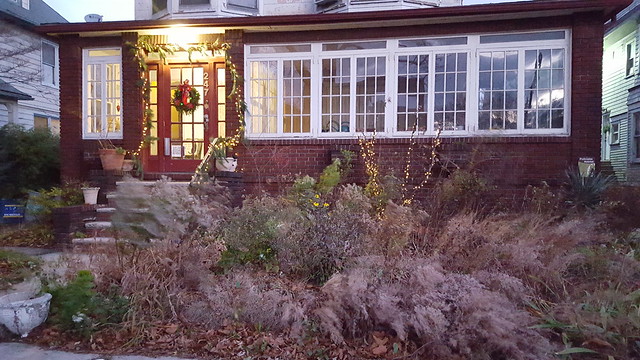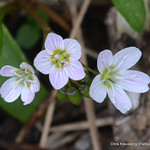This is a checklist of just the plant species native to New York City I’m growing in my garden. I’m posting this for the benefit of anyone attending the NYC Wildflower Week tour of my garden, Friday, May 15, from 1-3pm. It may also be of interest to those who attended Tuesday night’s meeting of the Long Island Botanical Society. I only had time during that talk – Place, Purpose, Plants: Urban Gardening with Native Plants – to highlight a handful of plants I’m growing.
Visitors are also going to get to witness a rare treat: “My little bees”, Colletes thoracicus, are actively nest-building in the garden right now. Most years, they would be finished by now, not to be seen until April of the next year. If we’re lucky, we will also get to see the Nomada sp. cuckoo bees I just noticed in my garden for the first time this year.
Adiantum pedatum, Maidenhair Fern, Pteridaceae
Ageratina altissima, white snakeroot, Asteraceae
Allium tricoccum, ramps, Liliaceae
Andropogon gerardii, NYC-local ecotype, Big Bluestem, Poaceae
Andropogon virginicus, Broom Sedge, Poaceae
Anemone canadensis, Canadian anemone, Ranunculaceae
Angelica atropurpurea, purplestem angelica, great angelica, American angelica, high angelica, masterwort, Apiaceae
Antennaria plantaginifolia, plantain-leaved pussytoes, Asteraceae
Aquilegia canadensis ‘Little Lanterns’, Eastern red columbine, Ranunculaceae
Aquilegia canadensis, Eastern red columbine, Ranunculaceae
Arctostaphylos uva-ursi, bearberry, Ericaceae
Arisaema triphyllum, Jack in the pulpit, Araceae
Asarum canadense, Canadian wild ginger, Aristolochiaceae
Asclepias incarnata, NYC-local ecotype, swamp milkweed, Apocynaceae
Asclepias syriaca, NYC-local ecotype, Common Milk Weed, Apocynaceae
Asclepias tuberosa, NYC-local ecotype, Butterfly Weed, Apocynaceae
Athyrium filix-femina ‘Lady in Red’, ladyfern, Dryopteridaceae
Baptisia tinctoria, NYC-local ecotype, False Indigo, Fabaceae
Carex laxiculmis ‘Bunny Blue’, spreading sedge, Cyperaceae
Carex pensylvanica, Pennsylvania sedge, Cyperaceae
Caulophyllum thalictroides, blue cohosh, Berberidaceae
Chelone glabra, white turtlehead, Scrophulariaceae
Chrysopsis mariana, NYC-local ecotype, Maryland Goldenaster, Asteraceae
Claytonia virginica, Virginia springbeauty, Portulacaceae
Clematis virginiana, virgin’s bower, devil’s darning needles, Ranunculaceae
Cunila origanoides, NYC-local ecotype, common dittany, Lamiaceae
Dichanthelium clandestinum, NYC-local ecotype, Deer Tongue, Poaceae
Elymus hystrix, NYC-local ecotype, eastern bottlebrush grass, Poaceae
Equisetum hyemale var. affine, scouring rush, Equisetaceae
Eragrostis spectabilis, Purple Lovegrass, Poaceae
Euthamia caroliniana, Slender Goldentop, Asteraceae
Eutrochium maculatum, NYC-local ecotype, spotted joe pye weed, Asteraceae
Fragaria virginiana, Virginia strawberry, Rosaceae
Gentiana andrewsii, Andrews bottle gentian, Gentianaceae
Geranium maculatum ‘Espresso’, spotted geranium, Geraniaceae
Geranium maculatum, spotted geranium, Geraniaceae
Helenium autumnale, NYC-local ecotype, sneezeweed, Asteraceae
Heliopsis helianthoides, smooth oxeye, Asteraceae
Hydrophyllum virginianum, eastern waterleaf, Hydrophyllaceae
Ilex verticillata ‘Southern Gentleman’, winterberry, male, Aquifoliaceae
Ilex verticillata ‘Winter Red’, winterberry, female, Aquifoliaceae
Ionactis linariifolius, Stiff Aster, Asteraceae
Juncus effusus, NYC-local ecotype, common rush, Juncaceae
Juncus tenuis, Path rush, Juncaceae
Krigia biflora, Two-Flower Cynthia, two-flowered dwarf dandelion, Asteraceae
Lespedeza capitata, Round-headed Bush Clover, Fabaceae
Lilium superbum, Turk’s Cap Lily, Liliaceae
Lobelia cardinalis, cardinal flower, Campanulaceae
Lobelia inflata, indian tobacco, puke weed, Campanulaceae
Lobelia siphilitica, great blue lobelia, Campanulaceae
Lonicera sempervirens, NJ-local ecotype, trumpet honeysuckle, Caprifoliaceae
Monarda fistulosa, NYC-local ecotype, wild bergamot, Lamiaceae
Oenothera biennis, common evening-primrose, Onagraceae
Onoclea sensibilis, sensitive fern, Dryopteridaceae
Opuntia humifusa, Eastern Prickly Pear, Cactaceae
Osmunda cinnamonea, cinnamon fern, Osmundaceae
Osmunda regalis, royal fern, Osmundaceae
Oxalis stricta, upright yellow wood-sorrel, Oxalidaceae
Packera aurea, golden ragwort, Asteraceae
Packera obovata, round-leaved ragwort, Asteraceae
Panicum virgatum ‘Cloud Nine’, switchgrass, Poaceae
Panicum virgatum, NYC-local ecotype, switchgrass, Poaceae
Parthenocissus quinquefolia, Virgina creeper, Vitaceae (Grape Family)
Penstemon digitalis, NYC-local ecotype, talus slope penstemon, tall white beardtongue, Scrophulariaceae
Phlox subulata, Moss Phlox, Polemoniaceae
Podophyllum peltatum, mayapple, Berberidaceae
Polygonatum biflorum, smooth Solomon’s seal, Ruscaceae
Polystichum acrostichoides, Christmas fern, Dryopteridaceae
Prunus maritima, beach plum, Rosaceae
Pseudognaphalium obtusifolium, Sweet Everlasting, Asteraceae
Pycnanthemum muticum, NYC-local ecotype, clustered mountain-mint, short-toothed mountain-mint, Lamiaceae
Pycnanthemum tenuifolium, Slender-leaved Mountain Mint, Lamiaceae
Pycnanthemum virginianum, NYC-local ecotype, Virginia Mountain Mint, Lamiaceae
Rhexia virginica, Virginia meadow-beauty, Melastomataceae
Rhododendron periclymenoides, pinxterbloom azalea, Ericaceae
Rhododendron viscosum, Swamp Azalea, Ericaceae
Rosa virginiana, Virginia rose, prairie rose, Rosaceae
Rudbeckia laciniata, cut-leaved coneflower, tall coneflower, Asteraceae
Saururus cernuus, lizard’s tail, Saururaceae
Schizachyrium scoparium, Little Bluestem, Poaceae
Solidago caesia, NYC-local ecotype, blue-stemmed goldenrod, Asteraceae
Solidago juncea, NYC-local ecotype, early goldenrod, Asteraceae
Symphyotrichum novae-angliae ‘Chilly Winds’, New England aster, Asteraceae
Thalictrum pubescens, NYC-local ecotype, tall meadow-rue, king of the meadow, Ranunculaceae
Thalictrum thalictroides, rue anemone, Ranunculaceae
Thelypteris noveboracensis, NYC-local ecotype, New York fern, Thelypteridaceae
Thelypteris noveboracensis, unknown provenance, New York fern, Thelypteridaceae
Thelypteris palustris, marsh fern, Thelypteridaceae
Trillium erectum, red trillium, Liliaceae
Vaccinium angustifolium, lowbush blueberry, Ericaceae
Vaccinium corymbosum, multiple cultivars, highbush blueberry, Ericaceae
Verbena hastata, Blue Vervain, Verbenaceae
Vernonia noveboracensis, New York ironweed, Asteraceae
Veronicastrum virginicum, Culver’s root, Scrophulariaceae
Viburnum dentatum, southern arrowwood, Caprifoliaceae
Viola lanceolata, Bog White Violet, Violaceae
Viola sororia, common blue violet, Violaceae
Zizia aurea, golden alexander, Apiaceae
About this list:
- This isn’t all of the “native” plants visitors will see in my garden. I have half again as many eastern North American species that are not native to NYC.
- This list doesn’t include any plants I’ve acquired this year; I don’t “count” anything until it’s survived a year of my gardening.
- My most treasured plants are those listed as “NYC-local ecotypes.” These have been propagated by the NYC Parks’ Greenbelt Native Plant Center from populations in and around New York City.
Related Content
Links




























